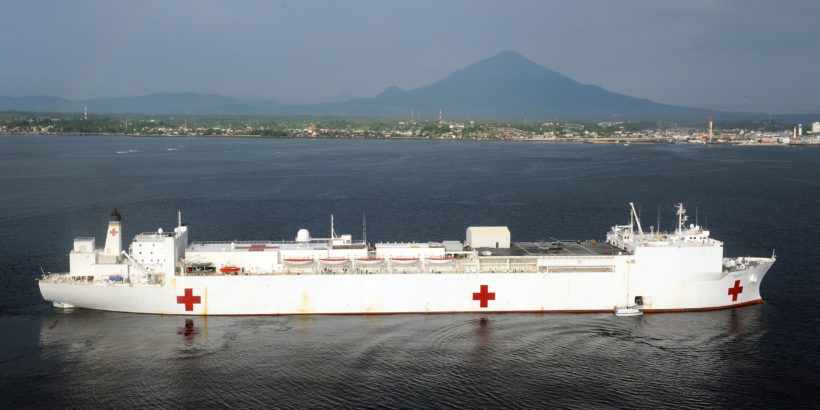The United States has decided to deploy its two hospital ships to assist with the ongoing crisis but using the ships might not be the best idea and I will explain why below.
There are two mercy class hospital ships that are used by the U.S. Navy. The two ships are the:
- USNS Mercy (T-AH-19)
- USNS Comfort (T-AH-20)
These ships are meant to provide emergency care for US combat forces but they also serve to provide relief in disaster areas.
Mercy primarily operates in the Pacific ocean. Her first military mission was in the Gulf War and her latest was in 2013, when she came to aid in the aftermath of Typhoon Haiyan. She would be used along the West Coast perhaps in Los Angeles or Seattle.
Meanwhile the Comfort operates primarily in the Caribbean and Latin America. Her first mission was in combat during Operation Desert Storm but she has been used in various crisis situations like in the aftermath of 9/11 and in 2017 to aid in Puerto Rico after Hurricane Maria. She will likely be used in New York.
Originally supertankers built in the 1970s by National Steel and Shipbuilding Company, these ships were converted into hospital ships in 1986 in 1987.
Each ship has 12 operating rooms, and houses 1,000 beds in its hospital facilities. They also contain other essential medical services like radiological services, medical laboratories, pharmacies, CT scan equipment, and oxygen plants.
Given the shortage of hospital rooms and beds that the country is facing in certain states like New York, an additional thousand beds could go a long way.
From what I understand, these hospital ships will be used to treat non-coronavirus patients and will simply serve to provide relief to overburdened hospitals. Essentially, they will open up beds in hospitals so that coronavirus patients will have beds in actual hospitals.
There are some doubts about the efficacy of using these ships.
For one, these are not the most efficient military vessels out there. They are slow and rely on outdated propulsion methods, making many feel like they are due up for retirement.
In wartime this means that they are vulnerable to attack, although it is considered a war crime and against the Hague Convention to attack a hospital vessel.
But beyond speed and their dated nature there are more pressing concerns.
There are also concerns about putting together a proper crew since there is already a lack of medical professionals readily available in many locations. These ships don’t have full-time crews. Yet, they will require about 1,000 people to keep these ships operating as they are essentially huge trauma centers.
The other issue is that they are reportedly not designed to deal with infectious diseases. Although they may not be used to treat coronavirus patients, it’s possible that the disease could be transmitted to people on board. Just like with cruise ships, things could spread very quickly.
So that is one reason why it is paramount to get the proper testing and PPEs in place so that disease does not spread in the ships. With proper testing and protective equipment, the odds of unknowingly spreading something throughout the ship will go down tremendously and these ships could potentially serve an important role in relieving the burden from our hospitals.
The USNS Comfort is still in a maintenance period so she would not be deployed for a couple of weeks while the USNS Mercy is ready to go based out of San Diego.
Daniel Gillaspia is the Founder of UponArriving.com and the credit card app, WalletFlo. He is a former attorney turned travel expert covering destinations along with TSA, airline, and hotel policies. Since 2014, his content has been featured in publications such as National Geographic, Smithsonian Magazine, and CNBC. Read my bio.


The way the U.S. is handling PPE across the nation, diseases will ultimately trickle over to these ships too as you sort of indicate. Basically, there’s no major hospital in the US that has their medical staff properly suited up for, even regular non-coronavirus patients. This entire situation was totally avoidable. Look at Italy, and how many doctors died with the lack of proper protection. It’s mind boggling. I’m just a regular citizen and have more PPE than doctors do, and most of my emergency supplies (which I have more than enough), like tyvek suits, shields and goggles are in storage back in the U.S. but I purchased the bulk of my stuff several years ago. And more recently stuff in Mexico. One thing for sure, after all of this is over, I bet every hospital will have a boatload of respirators, goggles, gloves, shields, and tyvek suits. That I can guarantee, unfortunately.
I believe you are correct — no medical facility will be impenetrable. Hopefully with more supplies the transmission rates will decrease drastically though. And I agree that when all of this is over A LOT of people are going to be doing things very differently.